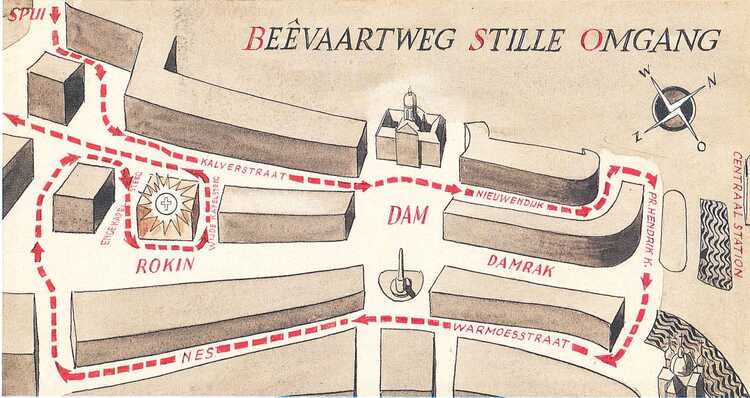In 1880, in the midst of the new craze for all things Gothic and mediaeval, a Catholic enthusiast Joseph Lousberg came into possession of several dubious documents and was told an oral tradition concerning sacramental processions which had been held in the Middle Ages. A year later, he walked the route as he had determined it together with a friend, Carel Elsenburg. In the middle of the night, in appropriate silence so as not to give offence to anyone. Two other friends joined them as they walked. Adriaan Apol and Henri de Veer. Their nocturnal perambulation became an annual event for the friends. Until in 1886, Bernardus Klönne, a miracle enthusiast and since 1883 rector of Begijnhof, discovered an eyewitness account and shared this with Lousbergh. At last, the route had a historical foundation, and moreover it had remained virtually intact - it was possible to walk the very same streets. Soon the silent procession was no longer a saunter by a small group of companions; it became a national event and indeed it still continues today on the night of Saturday and Sunday following the feast of the Miracle of Amsterdam.
What was it that Lousbergh had seen?
On 16 December 1651, the 91-year-old Agatha Hendrix Loen dictated a ‘Memoir of the Procession of the Miraculous Holy Sacrament from Holy Hearth in Amsterdam’ to her son in the presence of witnesses. She stated that while her age had left her sight impaired she nevertheless had full use of her mind or memory. Praise God. She described how the miraculous sacrament had been carried devoutly and solemnly through the streets of Amsterdam.
The procession started at Holy Hearth chapel. A crowd of worshippers would head from there down Kalverstraat towards Dam Square. There they would stop to recite prayers and the blessing of the Holy Sacrament. The monstrance with the Miracle wafer was placed on a barrel in the shape of small altar. Proceeding down Nieuwendijk and Raamskooi, the procession made its way to Nieuwebrug. Here, at the bridge, a blessing was recited for the assembled ships with the Sacrament to ensure that the Almighty provided for a safe voyage. Then the procession continued into Warmoesstraat, along Nes and Langebrugsteeg, across Langebrug and back again through Taksteeg to Kalverstraat where the throng walked around the Holy Hearth three times. The monstrance with its priceless Sacrament was then replaced in the shrine.
It is noticeable from the description how Nieuwebrug - new bridge - links the old, east side of town with the new, west side. It is in the middle of the bridge that the Nieuwe Kerk pastor handed the Sacrament to the rival Oude Kerk pastor.
The last time the procession was held was on 19 March 1578, shortly before the Catholic institutions and leaders of Amsterdam were disbanded and expelled on 26 May. Agatha was 18 when Amsterdam became a Protestant city.
For more information about the Silent Procession, see the Gezelschap van de Stille Omgang site: http://www.stille-omgang.nl/
SILENT PROCESSION
Each year, this year on the night of 22 and 23 March, a Silent Procession is held: a tradition that was revived in the late nineteenth century.

2052 keer bekeken
